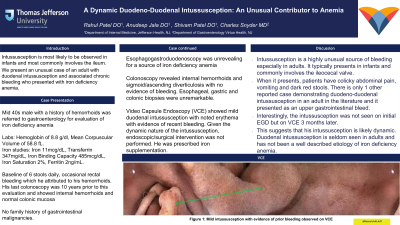Tuesday Poster Session
Category: GI Bleeding
P4192 - A Dynamic Duodeno-Duodenal Intussusception: An Unusual Contributor to Anemia
Tuesday, October 29, 2024
10:30 AM - 4:00 PM ET
Location: Exhibit Hall E

Has Audio
- RP
Rahul Patel, DO
Jefferson Health
Washington Township, NJ
Presenting Author(s)
Rahul Patel, DO1, Anudeep Jala, DO1, Shivam Patel, DO1, Charles Snyder, MD2
1Jefferson Health, Washington Township, NJ; 2Virtua Health System, Camden, NJ
Introduction: Intussusception is most likely to be observed in infants and most commonly involves the ileum. We present an unusual case of an adult with duodenal intussusception and associated chronic bleeding who presented with iron deficiency anemia.
Case Description/Methods: A man in his mid 40s with a history of hemorrhoids was referred to gastroenterology for evaluation of iron deficiency anemia with hemoglobin of 8.8 g/dl, mean corpuscular volume of 58.8 fL, iron studies: iron 11mcg/dL, transferrin 347mg/dL, iron binding capacity 485mcg/dL, iron saturation 2%, ferritin 2ng/mL. Upon interview, he reported a baseline of 6 stools daily, occasional rectal bleeding which he attributed to his hemorrhoids. His last colonoscopy was 10 years prior to this evaluation and showed only internal hemorrhoids and normal colonic mucosa. He denied any worsening episodes of rectal bleeding, abdominal discomfort, nausea, vomiting or weight loss. There was no family history of gastrointestinal malignancies. He initially underwent evaluation with an esophagogastroduodenoscopy (EGD) and repeat colonoscopy. EGD was unrevealing for a source of iron deficiency anemia, colonoscopy revealed internal hemorrhoids and sigmoid/ascending diverticulosis with no evidence of bleeding. Esophageal, gastric and colonic biopsies were unremarkable. Given a continued unclear etiology of anemia, video capsule endoscopy (VCE) was performed 3 months later. VCE showed mild duodenal intussusception with noted erythema with evidence of recent bleeding (figure 1). Given the dynamic nature of the intussusception, endoscopic/surgical intervention was not performed. He was prescribed iron supplementation.
Discussion: Intussusception is a highly unusual source of bleeding especially in adults. It typically presents in infants and commonly involves the ileocecal valve. When it presents, patients have colicky abdominal pain, vomiting and dark red stools. There is only 1 other reported case demonstrating duodeno-duodenal intussusception in an adult in the literature and it presented as an upper gastrointestinal bleed. Interestingly, the intussusception was not seen on initial EGD but on VCE 3 months later. This suggests that his intussusception is likely dynamic. Duodenal intussusception is seldom seen in adults and has not been a well described etiology of iron deficiency anemia.

Disclosures:
Rahul Patel, DO1, Anudeep Jala, DO1, Shivam Patel, DO1, Charles Snyder, MD2. P4192 - A Dynamic Duodeno-Duodenal Intussusception: An Unusual Contributor to Anemia, ACG 2024 Annual Scientific Meeting Abstracts. Philadelphia, PA: American College of Gastroenterology.
1Jefferson Health, Washington Township, NJ; 2Virtua Health System, Camden, NJ
Introduction: Intussusception is most likely to be observed in infants and most commonly involves the ileum. We present an unusual case of an adult with duodenal intussusception and associated chronic bleeding who presented with iron deficiency anemia.
Case Description/Methods: A man in his mid 40s with a history of hemorrhoids was referred to gastroenterology for evaluation of iron deficiency anemia with hemoglobin of 8.8 g/dl, mean corpuscular volume of 58.8 fL, iron studies: iron 11mcg/dL, transferrin 347mg/dL, iron binding capacity 485mcg/dL, iron saturation 2%, ferritin 2ng/mL. Upon interview, he reported a baseline of 6 stools daily, occasional rectal bleeding which he attributed to his hemorrhoids. His last colonoscopy was 10 years prior to this evaluation and showed only internal hemorrhoids and normal colonic mucosa. He denied any worsening episodes of rectal bleeding, abdominal discomfort, nausea, vomiting or weight loss. There was no family history of gastrointestinal malignancies. He initially underwent evaluation with an esophagogastroduodenoscopy (EGD) and repeat colonoscopy. EGD was unrevealing for a source of iron deficiency anemia, colonoscopy revealed internal hemorrhoids and sigmoid/ascending diverticulosis with no evidence of bleeding. Esophageal, gastric and colonic biopsies were unremarkable. Given a continued unclear etiology of anemia, video capsule endoscopy (VCE) was performed 3 months later. VCE showed mild duodenal intussusception with noted erythema with evidence of recent bleeding (figure 1). Given the dynamic nature of the intussusception, endoscopic/surgical intervention was not performed. He was prescribed iron supplementation.
Discussion: Intussusception is a highly unusual source of bleeding especially in adults. It typically presents in infants and commonly involves the ileocecal valve. When it presents, patients have colicky abdominal pain, vomiting and dark red stools. There is only 1 other reported case demonstrating duodeno-duodenal intussusception in an adult in the literature and it presented as an upper gastrointestinal bleed. Interestingly, the intussusception was not seen on initial EGD but on VCE 3 months later. This suggests that his intussusception is likely dynamic. Duodenal intussusception is seldom seen in adults and has not been a well described etiology of iron deficiency anemia.

Figure: Figure 1. Mild intussusception with evidence of prior bleeding observed on VCE.
Disclosures:
Rahul Patel indicated no relevant financial relationships.
Anudeep Jala indicated no relevant financial relationships.
Shivam Patel indicated no relevant financial relationships.
Charles Snyder indicated no relevant financial relationships.
Rahul Patel, DO1, Anudeep Jala, DO1, Shivam Patel, DO1, Charles Snyder, MD2. P4192 - A Dynamic Duodeno-Duodenal Intussusception: An Unusual Contributor to Anemia, ACG 2024 Annual Scientific Meeting Abstracts. Philadelphia, PA: American College of Gastroenterology.
